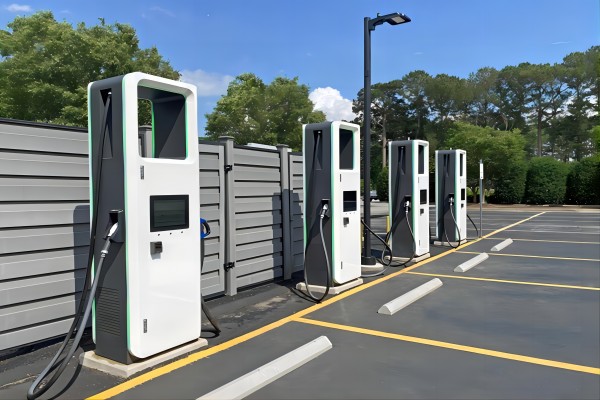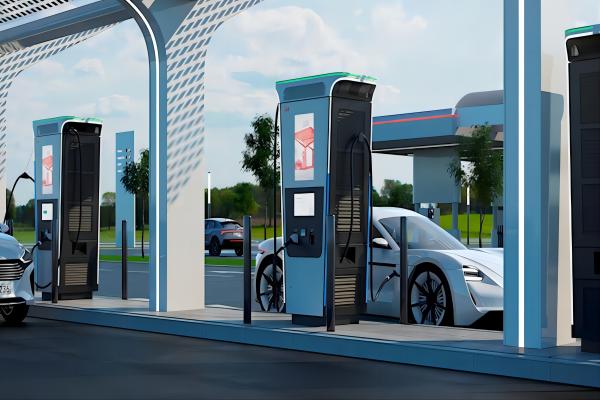In order to reduce dependence on oil resources, improve the global energy structure, and reduce pollution and greenhouse gas emissions, vehicle electrification has become a major trend. At present, in addition to China, European and American countries are also actively introducing new energy vehicle guidance bills to promote the development of the industry.
The global new energy vehicle market is still in a stage of rapid growth. According to statistics from Statista, the global new energy vehicle market is expected to reach US$384 billion in 2022. Facing the global market, China, as the largest producer of new energy vehicles, is also accelerating its “going overseas” for its own brand new energy vehicles.
Along with independent new energy vehicles, there are also charging facilities companies. With the increase in the number of new energy vehicles in various countries around the world, the demand for public charging piles and household charging piles is also increasing day by day. Many domestic charging facilities manufacturers are also targeting this opportunity and actively deploying overseas new energy charging markets.
According to the Southern Metropolis Daily, in the past two years, many domestic new energy charging facilities companies have applied for the European “going overseas” certification, and the number of certified companies has increased by nearly 200%. At the same time, non-related industry manufacturers who smelled business opportunities also quickly grabbed the overseas charging equipment market, trying to seize a certain share.
A “going overseas” competition for charging pile enterprises officially kicked off.

Whether it is the vitality of the new energy vehicle market or the demand for charging, China is undoubtedly the first in the world. In the minds of charging facility companies, the domestic market has unlimited business opportunities.
But at the same time, charging pile enterprises are also facing development bottlenecks in expanding their business in China. On the one hand, with the surge in sales of new energy vehicles, the charging demand of car owners remains high; on the other hand, the construction and regional layout of charging piles are very unbalanced.
According to reports, including public charging piles and private charging piles, the current domestic vehicle pile ratio is about 3:1, and it seems reasonable to have one charging pile for every three new energy vehicles. However, in the central area of first-tier cities with relatively dense population and concentrated new energy vehicles, the vehicle-to-pile ratio is obviously not so ideal.
“In the first-tier central area, the vehicle-to-pile ratio will be higher, the demand for charging is large, and the problem of charging difficulty is more prominent.” It stands to reason that where there is demand, there will naturally be a market, but Yang Tuo said frankly that in the central area of first-tier cities, It is also much more difficult for companies to expand new charging facilities.
First of all, the central area is very expensive. It is not a simple matter for companies to find suitable and low-rent sites to build fast charging piles, not to mention that in densely populated communities, the conditions for building charging stations are more stringent, ” Electricity supply, fire safety, these are all issues that businesses need to consider.”
As for slow charging piles, although there are no strict site restrictions, they can be built in residential and complex parking lots, but many community owners and complex properties have also restricted companies from entering the site and building piles due to the risk of electricity safety. “Many of the charging piles that come with the car can’t be given away, and the reason is the same.”
In densely populated central areas, parking spaces are relatively tight. Even with the consent of the property, the construction of slow charging piles in community and complex parking lots is often occupied by oil vehicles, which affects the operating income of the operator. “As for first-tier suburbs, third- and fourth-tier small cities, many charging piles are idle. , there’s not that much demand at all.”
In addition, the “head effect” of the domestic charging pile industry is obvious, and many second- and third-line charging pile brands can only find another way out and open up new incremental markets. Overseas markets, where the sales of new energy vehicles are showing a trend of rapid growth, have naturally become a blue ocean where companies are scrambling to deploy.

So, compared to the domestic charging pile market, are there more problems overseas?
The overseas market has even more problems than the domestic market, and the development status is more rudimentary.
Especially in some European countries, the development of the charging pile industry is more like China three or four years ago. Except for European countries such as Norway, the Netherlands, Germany and other countries that laid out charging infrastructure earlier, many European countries are facing charging problems.
Under the premise of the surge in sales of new energy vehicles in the European and American markets, the ratio of new energy vehicle piles in some Central and Eastern European and North American countries is continuing to expand, and charging difficulties are becoming more and more obvious. An overseas statistic shows that as of April this year, the vehicle-to-pile ratio in the U.S. market was as high as 21:1—that is, there is one charging pile for every 21 vehicles.
In the European market, there are many countries with a vehicle-to-pile ratio greater than 10:1. Although there is a large gap in facilities, many European and American countries also face the problem of outdated urban infrastructure, just like in China. The approval process is cumbersome and the population distribution is uneven, which undoubtedly increases the difficulty for enterprises to “go overseas”.
After all, compared with the domestic market, most European and American countries are not very densely populated. Although there are also big cities, many users live in the suburbs with quieter and larger living space. They only commute to and from the city for work and weekend shopping. Central region.
Therefore, in communities with low population density and no high-rise buildings, users’ demand for household charging piles is naturally greater. The October cross-border index released by Alibaba International Station shows that the top five countries in the global charging pile hot search are the United Kingdom, Germany, Ireland, the United States, and New Zealand.
The hot search index has shown a rapid growth trend since 2020, and the number of charging pile companies “going overseas” through cross-border e-commerce is also increasing.
According to Ernst & Young, by 2035, Europe will need to install 65 million charging piles to meet the charging needs of 130 million new energy vehicles, 85% of which are household charging piles.
Due to the large demand for household charging piles in the European and American markets, Chen Haiyang said that some domestic charging pile operating companies have begun to transform the design, manufacturing and sales of charging piles. As for his company, it is targeting the field of overseas public charging pile infrastructure.
Since the end of last year, the United Kingdom has introduced a new plan, requiring that new residential buildings must be equipped with charging stations (piles) for new energy vehicles; EU countries have also introduced corresponding plans and incentives. The scale of the new energy public facilities infrastructure market promoted by these plans cannot be underestimated, and the demand prospects are fascinating.
With the development of the new energy vehicle industry, some European and American countries have also begun to understand that, as a “small profit” industry, charging piles only rely on private capital and market mechanisms, and it is difficult to quickly deploy charging infrastructure in a short period of time, nor can it meet the growing market. need.
Germany recently approved a plan to invest 6.3 billion euros over the next three years to rapidly expand the number of charging stations for new energy vehicles across the country, as part of Germany’s push for net-zero emissions.
In the middle of this year, Austria also released the latest incentive measures for the construction of charging infrastructure: the measures will provide subsidies of up to 15,000 euros for public charging piles built by general enterprises according to the size of the charging capacity.
As early as the beginning of this year, the U.S. Department of Energy and the Department of Transportation announced that it will allocate nearly $5 billion over the next five years to help states strengthen the deployment of new energy vehicle charging services. And by 2030, it will reach the goal of having 500,000 public electric vehicle charging points in the United States. As Europe and the United States have “hindsight”, strong incentives have been introduced one after another. Domestic charging pile companies and operating agencies have also sensed business opportunities, and have planned to “go overseas” to seize the market and open a “gold rush” for overseas charging facilities. “upsurge.
Some data show that: at present, the sales penetration rate of new energy vehicles in Europe has been hovering around 20%, and the penetration rate of new energy vehicles in the United States is even less than 10%, which is lower than 30% in the domestic market. As the timetable for “burning out” approaches, the new energy vehicle market in Europe and the United States may see a strong growth momentum.














